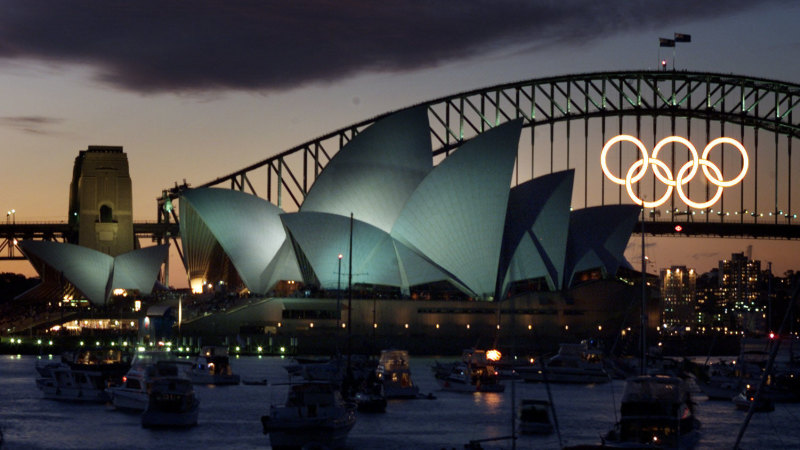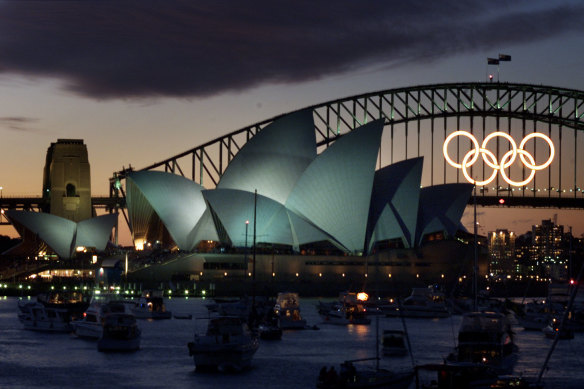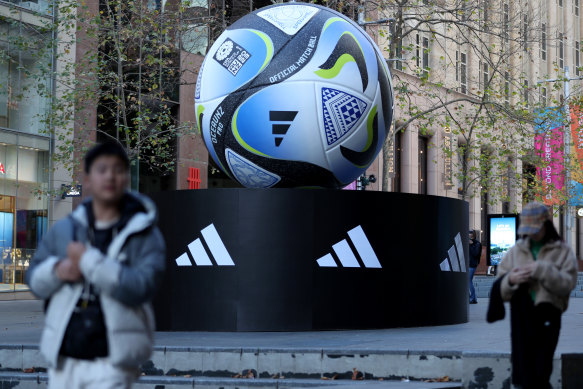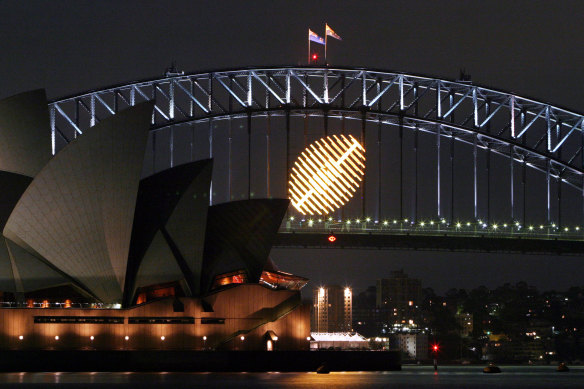Save articles for later
Add articles to your saved list and come back to them any time.
One of my most cherished non-sporting memories of the 2000 Sydney Games was the night when five classically interlaced Olympic rings were illuminated on the Harbour Bridge for the duration of the biggest event ever held in Australia.
It was a fabulous piece of branding, an image that was relayed around the world, serving as a backdrop for many international broadcasters. No wonder Sydney is remembered as one of the best-badged Olympics in history. The 2003 Rugby World Cup followed the rings on the bridge with an illuminated football.
The Olympic rings graced the Harbour Bridge for the period of the Sydney Olympics.Credit: Andrew Meares
Probably the second-biggest event to be staged Down Under since those Olympics is the FIFA Women’s World Cup, a 32-team gala that will conclude with the final this weekend. But while it’s been a massively resounding success in terms of attendances, organisation and the manner in which it has galvanised the nation behind women’s sport, at last, its reach and impact – even putting aside the stellar performance of the Matildas – has been wildly underestimated by our governments.
After all, FIFA, football’s ruling body, has confirmed that viewership in China – once Australia’s golden inbound tourism market – totalled almost 54 million, and that was to watch the national side be bludgeoned 6-1 by England.
Here in Australia, unless you’ve been at the stadiums for much, if not all, of the World Cup, strolling around our cities you’d hardly know the event has been on. Where was the symbolism on the Harbour Bridge in the city with the most games and the host of the final?
Chris Minns, the fledgling NSW premier, had to be dragged kicking, as it were, before reluctantly agreeing to light up the Opera House in support of the Matildas’ victorious match against Denmark.
What’s more, by the time you crossed the bridge after the end of the match, the light show on the Opera House had already been switched off. Talk about failing to bask in sporting glory.
Meanwhile, Dan Andrews, his Victorian counterpart, has been too busy burying a dead Commonwealth Games to see the potential of the Women’s World Cup.
On the subject of the nation’s sporting capital, Women’s World Cup matches were confined to only one venue – the boutique, small-capacity rectangular stadium – while the MCG and Marvel Stadium were unavailable, seemingly due to AFL commitments.
The Women’s World Cup is and has been a genuine major global event and one that’s set to grow exponentially in decades to come. How amazing would it have looked overseas had the Opera House been lit up throughout the tournament with great female footballers from around the world, not only the Matildas, celebrated?
There’s more than a whiff of sexism here. One has to ask whether a men’s World Cup would have received such scant celebratory attention in its host cities?
Many of us are gleefully guilty of jumping on the Women’s World Cup and Matildas’ bandwagon but politicians, having grossly underestimated the global impact of the event, are really the worst offenders.
Now the pollies have been flinging open venues beyond the main-event stadiums to harness the enthusiasm of the local public, having failed to do their bit to project Australia via the World Cup to a global audience.
No wonder that Fox Sports from the US, which has two massive pop-up studios established by Sydney Harbour at The Rocks, is said to have been mystified and bemused by the lack of branding or “party atmosphere” beyond the stadiums and live sites in the host cities. It meant Fox Sports didn’t have a landmark with some World Cup reference points to showcase to its audience in the US, one of Australia’s biggest tourism markets.
In Sydney, to find some symbol of the World Cup you need to go all of the way to Martin Place to see an oversized – but ultimately underwhelming – FIFA-sanctioned soccer ball.
The big match ball in Martin Place. Strolling around our cities, you’d hardly know the event’s been on.Credit: Getty
Fox Sports even erected its own individual markers representing and honouring each of the 32 participating nations right around the waterfront from the Park Hyatt hotel to near the Overseas Passenger Terminal.
Why should it matter and why is it worth spending the money on what may be dismissed as event frippery? Inbound tourism is still suffering from the effects of the pandemic. There’s a lingering perception, via Australia’s right or wrong draconian lockdown laws, that the country hasn’t been completely open for business, or worse, that overseas visitors weren’t as welcome as before COVID-19.
Look, by Sunday night, it’ll be over and Australia will be looking towards the next big thing in global sport. Perhaps that means another shot at the FIFA men’s World Cup, but Australia will definitely host the ever-growing Rugby World Cup in 2027 and Brisbane’s got the 2032 Olympic Games to look forward to.
So next time, let’s not forget that the whole world – and I mean the whole world – is watching and there are enormous tourism and branding opportunities for a far-flung nation like this one. Really, you don’t need a degree in major event marketing 101 to realise the missed opportunities.
A rugby ball illuminated on the Harbour Bridge for the 2003 Rugby World Cup, Credit: Steve Lunam
The Opinion newsletter is a weekly wrap of views that will challenge, champion and inform your own. Sign up here.
Most Viewed in National
From our partners
Source: Read Full Article




